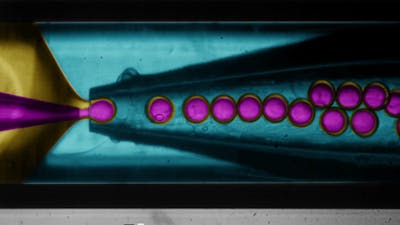Because of their large molecular sizes and properties, biologic drugs, be it in the form of monoclonal antibodies that target disease-associated molecules or active proteins and enzymes that may correct deficiencies in the human body, have proven difficult to deploy in many cases. Their therapeutic effects on target cells and tissues often require high and repeated dosing through intravenous administration, which can cause undesired side effects and physical discomfort in patients, and render many therapies excessively expensive.
To enhance the efficacy of biologic drugs and enable their administration via different routes to the human body, researchers at the Wyss Institute and the Harvard John A. Paulson School of Engineering and Applied Sciences (SEAS) have developed a highly programmable microfluidic drug formulation approach. This approach is able to package biologic drugs into microcapsules or microbeads with defined sizes, materials and structures to help tune their release in the body to their most favorable profile of action for a given therapy. Due to their high resistance to shear stress, the resulting microparticles can be injected via syringes under the skin, into muscle, or even delivered by minimally invasive techniques to internal sites in the body. Thus, the technology has the potential to simultaneously achieve more effective dosing, minimizing side effects and discomfort experienced by patients.

By expanding this microcapsule formulation approach with the capabilities to generate polymer-filled microbeads and by scaling up the formulation processes, the Wyss team created a versatile platform that is able to incorporate nearly 100% of a biologic drug into structurally defined microparticles with consistent sizes between 10 and 1000μm using FDA-acceptable chemistries and materials.
Users can choose between microbead and microcapsule formulating processes, a range of polymer materials with defined physical properties, pore sizes and biostabilities, and defined particle sizes with extremely high fidelity. This tunability creates exquisite control over a biologic drug’s release kinetics — covering the entire range between immediate and slow (or sustained) release — as well as its injectability. In future efforts, specifically formulated microparticles can also be functionalized with targeting molecules to further enhance the tissue-specific release of biologic drug payloads.
